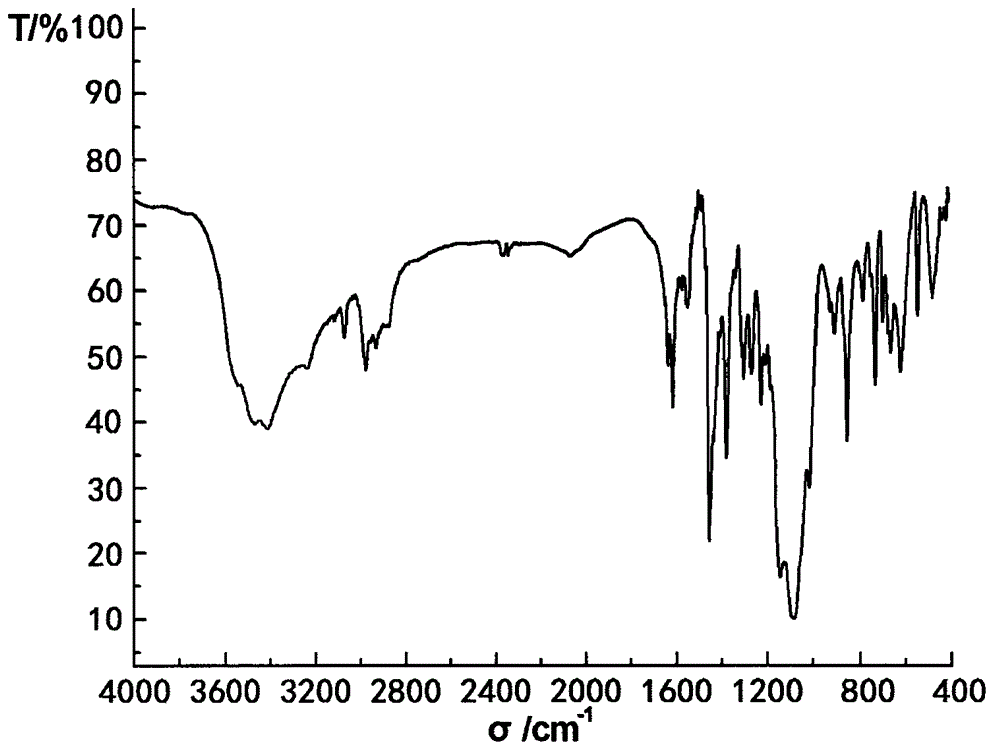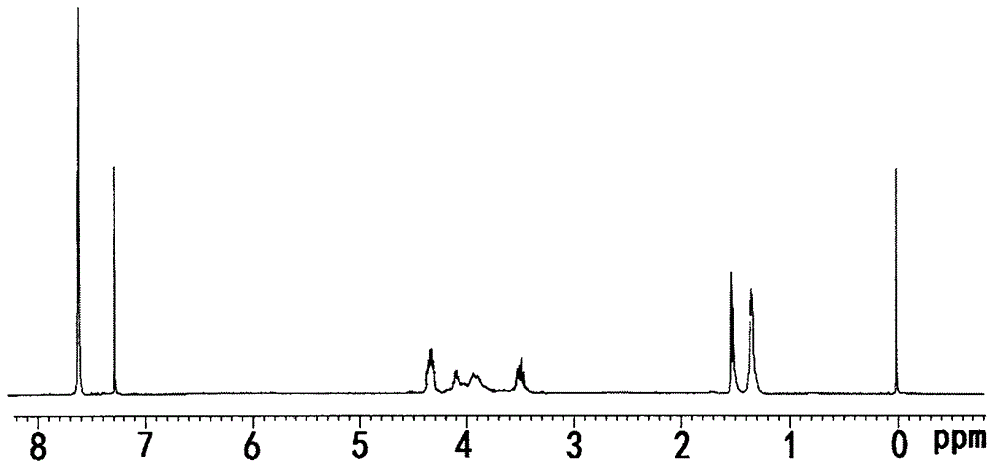Flame retardant silicic acid di-(tribromophenyl) dichlorohydrin compound and preparation method thereof
A technology of tribromophenyl and dichloropropyl ester, applied in the direction of silicon organic compounds, etc., can solve the problems of high price and application limitation of silicon-based flame retardants, and achieves overcoming volatile reaction, low production cost, and difficulty in dispersion. Effect
- Summary
- Abstract
- Description
- Claims
- Application Information
AI Technical Summary
Problems solved by technology
Method used
Image
Examples
Embodiment 1
[0029] Embodiment 1 In the 150ml four-neck flask that stirrer, thermometer, dropping funnel and high-efficiency reflux condenser are equipped with and an extremely stretchable and expandable soft sealing sleeve is housed on the condenser upper mouth, replace the nitrogen in the bottle with nitrogen. After the air, add 70ml of dioxane and 8.50g (0.05mol) of silicon tetrachloride, start stirring, and under cooling in an ice-water bath, add 2.90g (0.05mol) of propylene oxide dropwise, and control the temperature at 30°C with the dropping rate Below, after dropping, keep warm at 30°C for 30 minutes, refit the hydrogen chloride absorption device at the top of the condenser, add 33.08g (0.1mol) tribromophenol, raise the temperature to 85°C, keep warm for 4 hours, and cool down after the hydrogen chloride is released. To 40°C, restore the soft sealing sleeve device on the upper port of the condenser tube, then add 4.07g (0.07mol) propylene oxide dropwise, and control the temperature b...
Embodiment 2
[0030]Example 2 In a 150ml four-necked flask equipped with a stirrer, a thermometer, a dropping funnel and a high-efficiency reflux condenser and an extremely flexible and expandable soft seal at the top of the condenser, replace the nitrogen in the bottle with nitrogen. After the air, add 70ml toluene and 8.50g (0.05mol) silicon tetrachloride, start stirring, under ice-water bath cooling, add 2.90g (0.05mol) propylene oxide dropwise, control the temperature below 30°C with the dropping speed, drop After completion, keep the reaction at 30°C for 30 minutes, refit the hydrogen chloride absorption device at the top of the condenser, add 33.08g (0.1mol) tribromophenol, raise the temperature to 90°C, and keep the reaction for 3.5h. After the hydrogen chloride is released, cool down to 40 ℃, restore the soft sealing sleeve device on the upper port of the condenser tube, then add 5.81g (0.1mol) propylene oxide dropwise, and control the temperature below 50°C with the dropping speed. ...
Embodiment 3
[0031] Example 3 In a 150ml four-necked flask equipped with a stirrer, a thermometer, a dropping funnel and a high-efficiency reflux condenser and an extremely flexible and expandable soft seal at the top of the condenser, replace the nitrogen in the bottle with nitrogen. After air, add 70ml of carbon tetrachloride and 8.50g (0.05mol) of silicon tetrachloride, start stirring, and under cooling in an ice-water bath, add 2.90g (0.05mol) of propylene oxide dropwise, and control the temperature at 30°C with the dropping rate Below, after dropping, keep warm at 30°C for 30 minutes, refit the hydrogen chloride absorption device at the top of the condenser, add 33.08g (0.1mol) tribromophenol, raise the temperature to 70°C, keep warm for 6 hours, and cool down after the hydrogen chloride is released. To 40°C, restore the soft sealing sleeve device on the upper port of the condenser tube, then add 4.65g (0.08mol) propylene oxide dropwise, and control the temperature below 50°C with the ...
PUM
| Property | Measurement | Unit |
|---|---|---|
| flash point | aaaaa | aaaaa |
| decomposition temperature | aaaaa | aaaaa |
| density | aaaaa | aaaaa |
Abstract
Description
Claims
Application Information
 Login to View More
Login to View More - R&D
- Intellectual Property
- Life Sciences
- Materials
- Tech Scout
- Unparalleled Data Quality
- Higher Quality Content
- 60% Fewer Hallucinations
Browse by: Latest US Patents, China's latest patents, Technical Efficacy Thesaurus, Application Domain, Technology Topic, Popular Technical Reports.
© 2025 PatSnap. All rights reserved.Legal|Privacy policy|Modern Slavery Act Transparency Statement|Sitemap|About US| Contact US: help@patsnap.com



